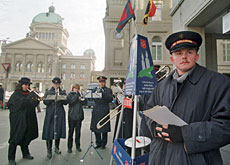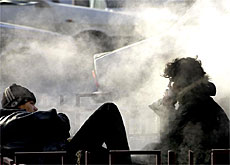Salvation Army marches on after 125 years

The Salvation Army in Switzerland is celebrating its 125th anniversary at a time when the gap between rich and poor is widening in the country.
The organisation has admitted, however, that it is facing a problem in attracting new recruits.
In Switzerland, the Salvation Army is confronting the problem of looking after not only the homeless and those who have slipped through the social net, but also an increasing number of women and young people.
According to the Catholic aid organisation Caritas, every seventh person is unable to take care of his or her needs, a situation it describes as a “social disaster”.
This comes at a time when social assistance is declining, making aid from non-governmental organisations such as the Salvation Army even more important.
Soup, soap and salvation
The Army’s traditional war cry ‘Soup, soap and salvation’ has been a blessing to many who have found closed doors elsewhere.
The Salvation Army in Switzerland operates a number of facilities for homeless and other people, namely 36 social hostels, five counselling centres, eight halfway houses for asylum seekers and four asylum coordination centres.
“The Salvation Army makes an important contribution against homelessness and also for people’s psychosocial needs with its centres,” Walter Schmid, president of the Swiss Conference for Social Assistance, told swissinfo.
A change has taken place over the years about how people seeking assistance are termed, with the unappealing title of “social case” dropped in favour of “client”.
People at heart
People are at the heart of the Salvation Army’s activities.
“Our commitment to people is essential and our motivation comes from our faith,” Salvation Army spokesman Pierre Reift said.
The Bible has remained the foundation of the organisation’s work against poverty, but the Salvation Army of today has become an important player in social care, which has its cost.
According to the financial figures for 2005, the Salvation Army’s income was SFr169 million ($140 million), SFr22 million more than the previous year.
About a third of the organisation’s income stems from donations and endowments, and a quarter comes from the government, cantons and communes. The organisation’s 28 second-hand shops also provide an important source of income.
Not only celebration
But the 125th anniversary is not only a cause for celebration.
“It has become more difficult for us to recruit young people,” Reift noted, adding that the main reason was not the “dusty looking appearance” of the uniform members wear.
“It’s a modern phenomenon that people do not want to commit themselves for long periods,” he said.
The Salvation Army aims to combat this with a new training concept.
“A possibility would be to offer practical experience in which young people can take courses for a limited amount of time or work in some of the Salvation Army’s activities,” Reift said.
He added that the three-year course to become an army officer at a training centre in Basel could be divided into modules. The training would be recognised so that students could be eligible to follow a university course.
As part of celebrations on Saturday, the Salvation Army was expressing thanks for 125 years of support by offering brunch around the country.
swissinfo, based on a German text by Renat Künzi
Salvation Army Switzerland
Income 2005: SFr169 million
Officers: 443
Members: Around 4,600
Volunteers put in some 40,000 days’ work a year.
The Salvation Army operates 36 social facilities, five counselling centres, eight halfway houses for asylum seekers and four asylum coordination centres.
It operates 28 second-hand shops.
The Salvation Army operates in 111 countries around the world. As a church and charity organisation, the Salvation Army demonstrates its Christian principles through social welfare.
The organisation has 1.6 million members and 16,000 church and community centres worldwide.
It is funded through donations from its members, the public and government grants.
The Salvation Army began work in Switzerland in 1882 when Catherine Booth, daughter of the founder of the organisation, arrived in Geneva.
Initially, it was not accepted but continued its work despite adversities. After three years, it opened branches in Zurich and Basel.
The Federal Court recognised it as a religious organisation in 1889.
On November 1, 1901 the Salvation Army opened its headquarters in Bern. Before then, it had been directed from the Paris headquarters.

In compliance with the JTI standards
More: SWI swissinfo.ch certified by the Journalism Trust Initiative

You can find an overview of ongoing debates with our journalists here. Please join us!
If you want to start a conversation about a topic raised in this article or want to report factual errors, email us at english@swissinfo.ch.